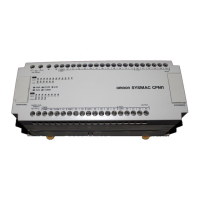Glossary
495
comparison instruction An instruction used to compare data at different locations in memory to deter-
mine the relationship between the data.
Completion Flag A flag used with a timer or counter that turns ON when the timer has timed out
or the counter has reached its set value.
condition A symbol placed on an instruction line to indicate an instruction that controls the
execution condition for the terminal instruction. Each condition is assigned a bit
in memory that determines its status. The status of the bit assigned to each con-
dition determines the next execution condition. Conditions correspond to LOAD,
LOAD NOT, AND, AND NOT, OR, or OR NOT instructions.
CONFIG.SYS An MS DOS file containing environment settings for a personal computer.
constant An input for an operand in which the actual numeric value is specified. Constants
can be input for certain operands in place of memory area addresses. Some op-
erands must be input as constants.
control bit A bit in a memory area that is set either through the program or via a Program-
ming Device to achieve a specific purpose, e.g., a Restart Bit is turned ON and
OFF to restart a Unit.
control data An operand that specifies how an instruction is to be executed. The control data
may specify the part of a word is to be used as the operand, it may specify the
destination for a data transfer instructions, it may specify the size of a data table
used in an instruction, etc.
control signal A signal sent from the PC to effect the operation of the controlled system.
Control System All of the hardware and software components used to control other devices. A
Control System includes the PC System, the PC programs, and all I/O devices
that are used to control or obtain feedback from the controlled system.
controlled system The devices that are being controlled by a PC System.
count pulse The signal counted by a counter.
counter A dedicated group of digits or words in memory used to count the number of
times a specific process has occurred, or a location in memory accessed
through a TIM/CNT bit and used to count the number of times the status of a bit
or an execution condition has changed from OFF to ON.
CPU See central processing unit.
CTS An acronym for clear-to-send, a signal used in communications between elec-
tronic devices to indicate that the receiver is ready to accept incoming data.
CY See Carry Flag.
cycle One unit of processing performed by the CPU, including ladder program execu-
tion, peripheral servicing, I/O refreshing, etc.
cycle time The time required to complete one cycle of CPU processing.
cyclic interrupt See scheduled interrupt.
data area An area in the PC’s memory that is designed to hold a specific type of data.
data area boundary The highest address available within a data area. When designating an operand
that requires multiple words, it is necessary to ensure that the highest address
in the data area is not exceeded.

